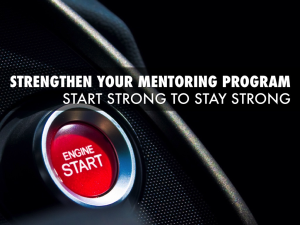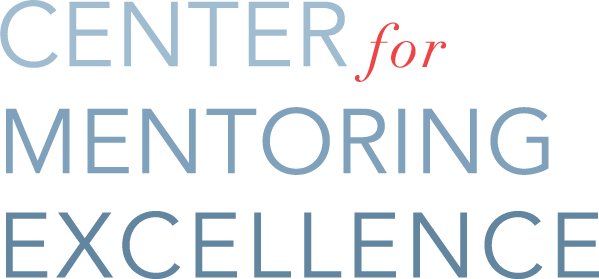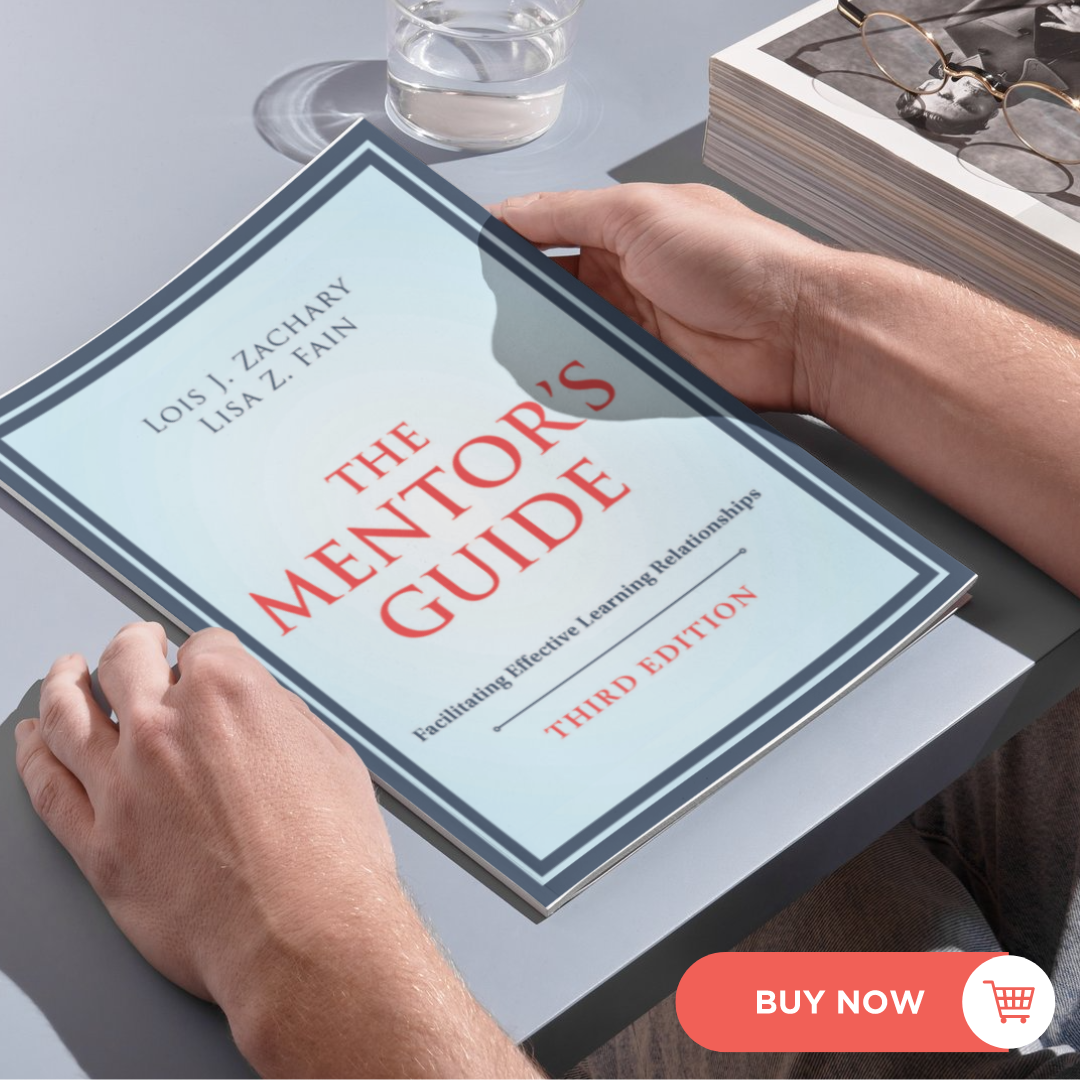by Center for Mentoring Excellence | Jan 12, 2015 | Making Mentoring Work For You, Mentoring Relationships
Starting Strong: A Mentoring Fable provides a view inside six successful mentoring conversations that take place over 90 days. The reader is privy to the thoughts and reflections of both the mentor and mentee, and gets to observe the personal dynamics of a successful mentoring relationship as it unfolds. It’s an excellent training resource because it models how good mentoring should look and feel.
Cynthia is one of the mentors you meet in the book. Cynthia learned the hard way about how to create a successful mentoring partnership. After a few failed mentoring relationships of her own, she grew from the experience. By the time she launched her next relationship, she was savvier and had a clearer understanding of what it takes to achieve tangible results.
 As a Program Coordinator, your mentoring pairs can benefit from Cynthia’s wisdom and experience. During the first 90 days of her relationship, she engaged her mentee in six essential conversations that led him to deepened insight and transformation.
As a Program Coordinator, your mentoring pairs can benefit from Cynthia’s wisdom and experience. During the first 90 days of her relationship, she engaged her mentee in six essential conversations that led him to deepened insight and transformation.
What made the difference for Cynthia? What did she do differently that made her more successful? In Starting Strong, you will learn about Cynthia’s strategies for mentoring success:
- Cynthia recognizes that her mentee will be uneasy as the more junior employee, mentored by a senior executive. She takes time to get to know him and put him at ease before launching into the work of mentoring.
- Some key structures and agreements help set the tone and expectations for progress and accountability. The mentee, who is new to mentoring, thought mentoring was an informal drop-in relationship.
- Learning is the purpose and product of mentoring — and its goals drive the learning. Mentors and mentees alike struggle with goal setting. It can be tempting for mentees to pick goals they can easy achieve or that aren’t relevant to their work success.
- Application of skills and learning are a critical part of mentee success.
- Stumbling blocks are inevitable in mentoring relationships. Mentors and mentees need a confidential, safe place to get coaching around issues that surface.
- The 90 day mark is an excellent time to schedule a check-in with mentoring partners.
How have you made the most of your first 90 days of mentoring?
Learn more about how to strengthen your mentoring relationships — order your copy of Starting Strong today.
And don’t forget — enter to win a free audio book copy of Starting Strong. Simply go to Twitter here, and retweet!
by Center for Mentoring Excellence | Jun 24, 2014 | Making Mentoring Work For You, Mentoring Relationships
In today’s connected world, mentoring for leadership and career development is easier than you might think. With collaboration and video conferencing tools, you can build relationships across the globe and develop your career from the comfort of your own home. Don’t get me wrong; meeting in person is always preferred. But, could you mentor remotely? Of course! Let me show you. Follow these five steps to launch your distance mentoring relationships into the cybersphere.
1. Incorporate Google tools in your mentoring work plan
From Google Hangouts to Google+, the search-engine super star has many gizmos that are perfect for mentoring. If you haven’t joined Google+, I highly recommend that you do so quickly. In addition, use Google Drive to share and collaborate on documents, projects and presentations with your mentors or mentees. It’s easy and makes working together simple and cooperative.
2. Create a LinkedIn group
With LinkedIn, you can produce and share content with large groups of people. But what about sharing content with a select few? The platform allows you to leverage groups to build a safe space to share experiences and to network.
3. Adopt a video conferencing tool
Meeting face-to-face is such an important part of building relationship. Now we have technology that can help. From iMeet to Fuze, there are many conferencing services available. With the right tool, you can connect with your mentees (or mentors) from anywhere and even maintain your meeting schedule. So, when you’re working on the road or traveling with your family, check in with your mentor and continue to build your relationship via video. If you have an iPhone, you can Facetime in to meetings and touch base with your mentees with the click of a button.
4. Use Twitter to connect
I expect my mentees to continuously grow their careers and develop as people. When I can’t see my mentees, or I have to miss a meeting, Twitter allows me to stay in touch. You can use the platform to check in, comment on work or add your two cents to project or personal development. Want to send a private message? The platform offers that function as well. Don’t fret the 140-character limit; it can be a blessing — trust me.
5. Encourage your mentees to use social media
Social media is an excellent place to build a professional network, find a mentor and nourish your relationships — use it. You should use Twitter, Facebook, LinkedIn, Google+ and Pinterest to share your ideas and build a community of people that share your interests. The world has never been more connected, so get out there and meet people.
As you can see, there are many tools out there to help you stay connected and continue to build your professional relationships. It’s up to you to use them.
If you have questions, contact us. We’re here to help you.
by Center for Mentoring Excellence | Dec 17, 2013 | Making Mentoring Work For You, Mentoring Relationships
It’s holiday time and gift-giving is on everyone’s mind. But how about those intangible gifts that are not wrapped up in packages and tied with a bow?
Time is one of them. When you carve out the time to mentor someone it is indeed a very special gift. Your gift of time tells that person that they matter to you, and that you value them. On the other hand, when you repeatedly postpone or cancel meetings, it sends a different message– my time is too valuable for you, our time together isn’t important or you are not worth the investment of my time.
 Remember Stephen Covey’s Four Quadrant Model? Covey makes the distinction between urgent and not urgent activities and those things that are important and not important. Urgent and important items are the crises, pressing problems and deadlines that get most of our attention. We tend to put off things that are deemed important, but are not urgent – like mentoring and personal development. Because they lack urgency nothing compels us to act immediately. Like many people, you might find yourself putting mentoring on the back burner, confident that you will get to it when the crisis du jour is over. Even with the best of intentions you don’t, because sooner or later another crisis takes its place.
Remember Stephen Covey’s Four Quadrant Model? Covey makes the distinction between urgent and not urgent activities and those things that are important and not important. Urgent and important items are the crises, pressing problems and deadlines that get most of our attention. We tend to put off things that are deemed important, but are not urgent – like mentoring and personal development. Because they lack urgency nothing compels us to act immediately. Like many people, you might find yourself putting mentoring on the back burner, confident that you will get to it when the crisis du jour is over. Even with the best of intentions you don’t, because sooner or later another crisis takes its place.
If you are waiting to find the time to give to mentoring others, forget it. You will never find the time unless you make sure you make it a priority. Time has a way of slipping by and with it goes the opportunity to make a difference in someone’s life.
What You Can Do
- Put mentoring dates and time on your calendar well in advance.
- Commit making time for mentoring a priority.
- If you have to reschedule, do it ASAP.
- Select the tasks, assignments, decisions, etc. you can delegate to someone else so you can free up your calendar. (Ideally, your delegation should provide an opportunity for someone else to grow and develop.)
- Use planning and time management strategies to make good use of the time you do have.
Questions to Consider
- Where does the priority of mentoring currently fit in your world?
- Who could really benefit from quality time with you?
- How available and accessible are you to the people who need you?
- What tasks are you doing now that someone else could do?
by Center for Mentoring Excellence | Dec 6, 2013 | Making Mentoring Work For You
It is not too early to begin thinking about your new year’s resolutions. We’d like to suggest that while you plan on improving your health, fitness, and financials in 2014, you also think about powering up your personal mentoring practice.

If you are motivated to raise your bar on mentoring next year, here are a few ways to turn your intentions into to a reality:
#1: Identify lessons learned. Make time to sit back and reflect on your mentoring experiences this year. What did you learn from your mentoring partner(s)? How are you using what you learned?
#2: Celebrate strengths. Think about what it is you did or said that worked particularly well in your mentoring relationships. Be as specific as you can. If you’ve kept a mentoring journal, now is the time to take another look at it. Plan to maximize your assets in the New Year.
#3: Recognize missed opportunities. We all have experiences that we wish had gone better. We may not have expressed something that needed to be said, candy-coated feedback when we could have been more forthright, or not followed through on something we’d promised. What do you wish had gone better in your mentoring relationships this past year? What got in your way? Ask your mentoring partners for feedback.
#4: Identify growth opportunities. In what ways have you grown as a mentor or a mentee? What new approaches have you tried this past year? In what ways, have you challenged and stretched yourself? Are you more effective in your mentoring role now than you were a year ago? How can you accelerate your gains this coming year?
#5: Develop a game plan. Identify specific skills, approaches and competencies you need to learn and develop to take your personal mentoring practice to the next level. Then, consider how you are going to go about acquiring the skills and knowledge you need to move forward. Craft a development plan that includes milestones and time frames and opportunities to try out new skills.
Remember: No matter how many times you engage in mentoring you can always get better at your practice. There is no better time to start than right now.

by Center for Mentoring Excellence | Jun 5, 2013 | Making Mentoring Work For You
Organizations need to support and pay attention to informal as well as formal mentoring within their organization. Both are important and critical to employee growth and development.
How do you differentiate the two?
Formal mentoring is commonly associated with the words organized, proscribed, structured, facilitated and supported. While these words describe many mentoring programs, the term itself actually refers to mentoring that is conducted under the umbrella of an organizational entity. Program parameters are defined and include structural and accountability mechanisms. There are programmatic and relationship expectations, requirements for eligibility and program goals and outcomes that give mentoring its formal feel.
Informal mentoring, in contrast, is usually described as unstructured, casual, need-based, and natural. For example, you may have identified someone in whom you see great promise and who could benefit your experience or someone may have approached you and asked you to mentoring them. Informal mentoring relationships can, and often do, run the gamut from casual catch-as-catch-can conversations or situational and information sharing to structured and “formalized” relationships. Each relationship proceeds at its own pace and on its own timetable.
Even in formal mentoring, each relationship structure varies depending on the learning needs and style of the mentoring partners. Once you are inside and working the relationship, it becomes a dance of two or more people coming together in partnership to move learning and development forward. As Huang and Lynch so beautifully capture it, “It is the dance between [] willing and consenting partners, a dance of giving and receiving each other’s gifts.”
by Center for Mentoring Excellence | Mar 13, 2013 | Making Mentoring Work For You
Confidentiality: A Slippery Slope
 Does the conversation that occurs between a mentor and mentee necessarily remain confidential during a time when the mentee is being considered for a career move? Or, when a leadership team sits to talk about whether to move someone who has been a mentee, can the mentor add to the conversation from his or her experience with the mentee? Or, is the conversation between the mentor and the mentee always strictly confidential?
Do you have any guidelines on this question? (more…)
Does the conversation that occurs between a mentor and mentee necessarily remain confidential during a time when the mentee is being considered for a career move? Or, when a leadership team sits to talk about whether to move someone who has been a mentee, can the mentor add to the conversation from his or her experience with the mentee? Or, is the conversation between the mentor and the mentee always strictly confidential?
Do you have any guidelines on this question? (more…)
 As a Program Coordinator, your mentoring pairs can benefit from Cynthia’s wisdom and experience. During the first 90 days of her relationship, she engaged her mentee in six essential conversations that led him to deepened insight and transformation.
As a Program Coordinator, your mentoring pairs can benefit from Cynthia’s wisdom and experience. During the first 90 days of her relationship, she engaged her mentee in six essential conversations that led him to deepened insight and transformation.





